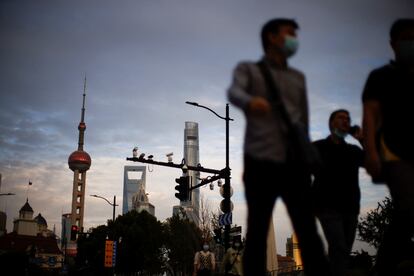China growth forecast to lag behind Asia-Pacific region for first time since 1990
The World Bank has lowered its 2022 expectations for the economic giant to 2.8%, a sharp downturn from the 8.1% expansion of last year


The specter of China’s zero covid policy has returned to claim its economic dues. According to a World Bank report published on Tuesday, in 2022 China will grow at a slower rate than the rest of the countries in the East Asia and Pacific region, the first time this has been the case since 1990. After more than a year of crippling uncertainty, lengthy lockdowns and the closures of megacities such as Shanghai, the second-largest economy on the planet will cease to be the engine of Asian growth for the first time in over three decades. The World Bank has lowered its 2022 growth forecasts for China to 2.8%, a sharp downturn from the 8.1% expansion of last year. Meanwhile, GDP in the rest of the region is expected to rise to 5.3%, compared to 2.6% in 2021. The ailing Chinese real estate sector, which represents around 30% of annual GDP, is among the main reasons for the country’s economic deceleration.
OUT NOW: #EastAsiaPacific is sustaining growth, restraining inflation, but facing risks ahead, says @WorldBank’s new #EAPUpdate📊➡️ https://t.co/uwMa5OWzLS [1/2] pic.twitter.com/a3DsrTCPPz
— World Bank East Asia Pacific (@WB_AsiaPacific) September 27, 2022
EU Chamber of Commerce warns of “loss of confidence” in China
“China’s success in containing Covid-19 infections has come at a significant economic cost,” notes the World Bank, which has been lowering forecasts for China as the Covid lockdowns imposed on various large cities have taken their toll. In its April economic outlook forecast, China’s growth was projected at 5% this year, in line with the forecasts of the Chinese authorities of around 5.5%. But strict coronavirus restrictions during the second quarter in key cities for the country’s industry and services sectors severely hampered an economy that grew by just 0.4% during the period.
China’s policy in dealing with coronavirus is at the root of almost everything, the report states. Post-pandemic recovery in much of the East Asia and Pacific region has been driven by the pull of domestic demand, which in turn was made possible by the relaxation of Covid restrictions and increased exports. Meanwhile, a recent study by the European Union Chamber of Commerce warned of a “loss of confidence” in China among European businesses and the possible flight of these to “other emerging markets” in the region, a shift that has been based largely on China’s Covid measures. However, the World Bank issued an improved forecast for 2023, when the most populous country in the world is expected to grow by 4.5%. This is still below the forecast for China’s neighbors, where growth is expected to reach 5%.
China, which accounts for 86% of total production in the region covered by the report, remains one of the few countries in the world – and the only one among the major economic powers – to persevere with a strict zero-covid policy. While the European Union and the United States have elected to live and work with the coronavirus, Beijing “has continued its approach,” the report notes, “using mass testing and targeted mobility restrictions to contain outbreaks of the disease.” These measures, the report continues, “disrupt supply chains, industrial and services sector productivity, domestic sales and exports.”
Beijing’s restrictions are motivated, the report states, by concerns that a spike in Covid-19 infections could overwhelm the capacity of the health system, especially in rural areas, where the number of unvaccinated people among vulnerable groups remains “significant.” But while these measures have been successful in tackling the spread of the virus, the report adds: “Empirical analysis shows that these public health measures affect economic activity.”
“There is a desperate need for this zero-covid policy to change”Zhang Jun, director of the China Center for Economic Studies at Fudan University
Given the worrying situation, all eyes in Beijing are turned to the upcoming 20th National Congress of the Chinese Communist Party, the great five-yearly political event at which it is widely expected that Xi Jinping will pick up the baton again for a historic third term. No changes in policy are likely before the congress convenes on October 16, or until the culmination of the political process when a new government is appointed in March 2023. However, there is growing uneasiness and fatigue among different sectors of the population.
“I think there is a desperate need for this [zero-covid] policy to change,” Zhang Jun, director of the China Center for Economic Studies at Fudan University in Shanghai, tells EL PAÍS. In his opinion, it is unlikely that the general framework of China’s pandemic strategy will disappear overnight, but he believes that the government will allow local administrations to “progressively accommodate” new measures to make the economy “more resilient and dynamic,” by lifting restrictions on the movement “of people and factors of production.”
“This year will be a year of economic difficulties,” Zhang concedes, “but from next year onwards, the situation should improve through change in policies.” However, the analyst does not foresee a return to the days when China posted hyper-growth figures, but rather a “moderate” expansion of around 5%, following the trend of the last few pre-Covid years.
The World Bank also warns of turbulence in China’s real estate sector, which it describes as an example of “pre-existing difficulties accentuated by financial constraints” and caused by the “unsustainable accumulation of debt by developers.” The real estate sector accounts for 30% of China’s economy – taking into account everything from construction to services – but has suffered a “severe slowdown,” with sales and housing prices plummeting, “although the direct exposure of systemically important banks to real estate lending is limited,” the report concludes. The World Bank advises introducing measures such as providing more temporary liquidity to support real estate development.
The World Bank report concludes its analysis with an overview of the effects of a general global economic slowdown in other regions of the world, citing rising energy prices, continuous supply chain disruption and the rise in interest rates, which in turn have caused capital outflows and currency depreciations in some countries in the East Asia and Pacific region. Despite the fact that this region is expected to grow at a faster rate and to experience lower inflation than other regions in 2022, doubts persist due to the risk that a global slowdown will reduce the level of exports, coupled with the rise in fuel and food prices. “Policymakers face a difficult trade-off between fighting inflation and supporting economic recovery,” Aaditya Mattoo, Chief Economist of the East Asia and Pacific Region for the World Bank, said in a statement.
Tu suscripción se está usando en otro dispositivo
¿Quieres añadir otro usuario a tu suscripción?
Si continúas leyendo en este dispositivo, no se podrá leer en el otro.
FlechaTu suscripción se está usando en otro dispositivo y solo puedes acceder a EL PAÍS desde un dispositivo a la vez.
Si quieres compartir tu cuenta, cambia tu suscripción a la modalidad Premium, así podrás añadir otro usuario. Cada uno accederá con su propia cuenta de email, lo que os permitirá personalizar vuestra experiencia en EL PAÍS.
¿Tienes una suscripción de empresa? Accede aquí para contratar más cuentas.
En el caso de no saber quién está usando tu cuenta, te recomendamos cambiar tu contraseña aquí.
Si decides continuar compartiendo tu cuenta, este mensaje se mostrará en tu dispositivo y en el de la otra persona que está usando tu cuenta de forma indefinida, afectando a tu experiencia de lectura. Puedes consultar aquí los términos y condiciones de la suscripción digital.
More information
Últimas noticias
Most viewed
- Sinaloa Cartel war is taking its toll on Los Chapitos
- Oona Chaplin: ‘I told James Cameron that I was living in a treehouse and starting a permaculture project with a friend’
- Reinhard Genzel, Nobel laureate in physics: ‘One-minute videos will never give you the truth’
- Why the price of coffee has skyrocketed: from Brazilian plantations to specialty coffee houses
- Silver prices are going crazy: This is what’s fueling the rally










































